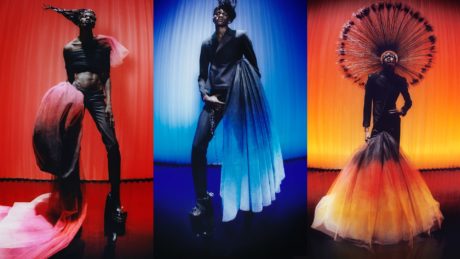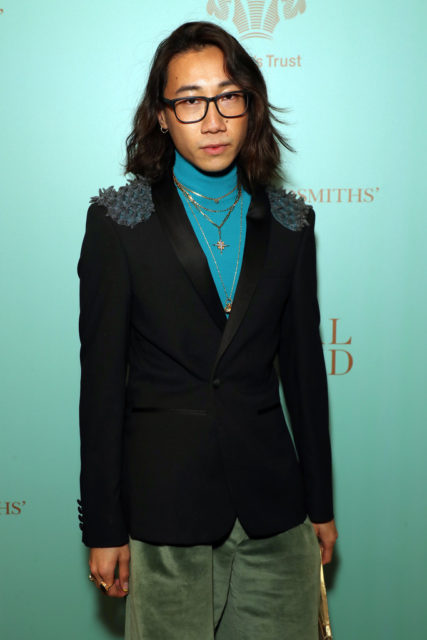LONDON – The London fashion scence has been irrevocably altered as a result of the lockdown and Brexit.
The majority of London’s Fashion Week’s mainstays have left, preferring Paris – or even the metaverse – to the city’s more intimate, low-budget runways.
So, without Jonathan Anderson, Victoria Beckham, Burberry, Christopher Kane, or Mary Katrantzou to headline London Fashion Week, what will become of the city’s fashion scene? Will there be any notable industry figures in attendance this event?
While the calendar, which ran from February 18 to 22, was much slimmer and attendance figures were lower, London remains in the discourse – because there are new sheriffs in town who are serious about their jobs.
A new generation of designers is on the rise: Most of them graduated during the pandemic and, despite all odds, became resourceful. They designed collections from their apartment shares, built communities on Instagram, attracted celebrity attention, and stood up for what they believe in – ethical production, unapologetic self-expression and gender fluidity, to name a few values at the top of their agendas.
They are now ready to enter the new, post-lockdown scene and put on shows to remember, having been deprived of the graduation catwalk show they’ve grown up dreaming about.
What is the ultimate goal? Bring back the kind of performance and emotion associated with fashion’s glory days, before fast-fashion and large corporations swept in.

“I wanted theatricality and a moment no one was going to forget; we’ve all been craving it. That’s why I’ve been thinking to myself how can we immerse people into the show? How can we be transformative? I realized I’m a showman as much as a designer,” Harris Reed, one of the brightest stars of the British capital’s new scene, who won London Fashion Week before it even started remarked.
A surprise performance by Sam Smith, a dreamlike set of 18-foot-tall clouds, and some excellent tailoring mixed in with larger-than-life feather headpieces and gowns were among the highlights of his intimate show, staged off-schedule on Thursday, the evening before the showcase’s formal debut.
“We’re very much going for a f–k off, old-school McQueen, Galliano, London show. I know people talk about McQueen way too much, but all those early McQueen days were about a performance, excitement and artistry,” says the designer. “Pieces that made people think, not the kind that would be immediately stocked in a store after,” Reed added.
Many of Reed’s peers are approaching the week with the same desire and determination to leave an indelible mark on the fashion world.
“The setbacks of the pandemic were good fuel. This anguish, the feeling of having been dealt with a bad hand only makes you more hungry for the future,” said Conner Ives, a graduate of Central Saint Martin’s class of 2020 who is set to make his highly anticipated catwalk debut on Friday, promising to resurrect the energy of the 90s catwalos and bring back the “bygone era of fashion.”
The country’s political and financial woes aren’t deterring them – in fact, the country’s turmoil of skyrocketing taxes, spiraling inflation, and enormous economic inequality under Boris Johnson’s conservative government is adding fuel to the fire of these young creatives, just as political and economic turmoil fueled John Galliano, Lee McQueen, and others in the 1990s.
These designers were also able to cut out the noise and hone their own sensibilities in all their over-the-top, eccentric grandeur, after spending two years in relative solitude and separated from the now broken fashion industry.
The days of homogenous, trend-driven collections are long gone. Love them or hate them, this new generation of designers is creating daring, visually captivating collections that will leave no one indifferent.
“It’s no longer the time to be answering to anyone else. It’s a time to create whatever we want, whatever makes us happy. At the end of the day, if you’re making pieces you believe in, people will see that,” said Chet Lo, an Asian American designer known for his electric-hued, spiky knitwear that’s sheer, figure-hugging, and designed to make the wearer feel beautiful.

“When people wear my pieces, I want them to feel confident in their own body and spirit. I’m just trying to put forward any kind of way that you can feel hot,” Lo said, adding that he frequently dares buyers to violate convention and choose his extra-short sheer designs over alternatives.
The bolder approach is succeeding at a time when shops need to provide stronger points of view to distinguish apart.
“It’s so exciting to see this new wave of designers not following trends. Each of their aesthetics is completely individual and really speak to the new generation of customers searching for a strong and unique fashion point of view,” said Elizabeth, von der Goltz, Matchesfashion’s chief commercial officer, adding that the company is exploring new ways of collaborating with these brands.
“A lot of our new designers work with one-of-a-kind or deadstock fabric, which can have its limitations, but can also mean these limited-edition pieces are more in demand due to their scarcity.”
This is a style that is appropriate for both men and women. “Man or woman, it’s so personal how each one of us wants to express themselves. So I try to stay as open as possible, make sure that styles cross genders, and be in close contact with customers who might have questions about fit,” Lo explained.
Reed’s work, as well as his larger aim, is based on fluidity. He believes the business and society as a whole are ready to listen more intently after succession of successful mainstream collaborations, ranging from MAC makeup to Missoma jewelry.

“Because of the amount of attention that the work has gotten over these past couple of years, people are now realizing that maybe they should actually invest the time and money to see if this made-to-measure, fluid model works,” he explained. “Early on, it felt like it was just me yelling into the void and yelling into Instagram, with support coming from young people like me and a couple of industry people who took notice. But now I’m in a place where I have to do less screaming and more constructive talking. The numbers from our different business ventures prove my point, so I’m also learning to talk people’s language more.”
Another distinguishing feature of this new generation of designers is that they are capable of conducting businesses and are keen to challenge the reputation of the hot young things who are very creative but financially ignorant.
Lo, for example set up his Instagram shop and e-commerce platform after graduating in 2020 because he couldn’t find work and needed to pay his rent. His distinct take on knitwear saw him swiftly “blow up” on Instagram and launch his own booming direct-to-consumer business, allowing him to be more choosy about the retail partners he works with and set his own pace.
“I do love working with certain wholesalers, but for me it’s a little too fast-paced, and I’d love to eventually branch out and work outside of the calendar, presenting something when I’m ready not because we have to go to market,” Lo explained. “Selling d-to-c [direct-to-consumer] is also incredibly sustainable, because everything is made to order and there’s never extra products sitting around. Even watching Harris do it has been incredible. He showed me that there was another way.”
Lulu Kennedy, who championed Lo’s work from the start, inviting him to participate in the Fashion East event, praised the designer for his out-of-the-box thinking in both his business and his “defined” aesthetic.
“I’m loving watching a lot of the dusty old rules getting ignored and young designers find a pace and structure that suits them better, like being selective with wholesale accounts and selling direct-to-consumer, not rushing things. It doesn’t matter so much if you’re showing at a specific fashion week, doing runway or not; if the work is good, it will cut through the noise,” Kennedy explained.
Ives, too, stated that he plans to present once a year and use largely repurposed materials. “Our industry really made a lot of commitment over lockdown, but eight months later everyone was on a plane to Milan, going to markets. That doesn’t sit well with me and I realized I need to be the change I want to see. I hope more designers can see what I’m doing and follow suit,” the designer stated.
Read has always followed his own set of rules, displaying off-the-cuff, adhering to a demi-couture model, and generating additional cash through blockbuster partnerships. He also has a new line of “fluid essentials” for those times when his customers need to change out of their kick flares, lace blouses, or extra-large platforms.
“My business has been around for three years and we’ve turned a profit every single year. I do think that demi-couture and made-to-measure are the future and it’s been profitable for us: The last gown that went to Selfridges sold for 10,000 pounds on the first day, from the window,” Reed remarked.
“We’re generally perceived as creative creatures, but because we’re young and enjoying ourselves, it’s almost as if we’re foolish or don’t grasp the ramifications of running a business.” But I’ll be the first to say, “No, I’m a headstrong b–ch and a damn good businessperson,” wearing 8-inch boots, a feathered headdress, and bleached eyebrows.
This didn’t happen because I was frivolous or wealthy; it happened because I made sensible business decisions, stuck to my guns, and believed that this kind of fluid beauty could make a mark.”
What’s more refreshing is that they don’t have an issue with attitude and prefer camaraderie than rivalry.
“There’s been a significant shift in the narrative. When I spoke with students who had previously worked with the former tutors at Central Saint Martins, they were putting them against one another. ‘This is your competitor, keep an eye on your back,’ was the mentality. And everyone smiled and grinned as if it were a good thing. But now we could just stop and say, ‘What the f–k are we fighting about?'” Reed added. “I’m not sure if it’s because of headspace, but all of my friends are now in therapy, and we all openly discuss our mental health.” The importance of mental wellness is enormous.”
That’s why you’ll often see Reed stomping up and down the corridors of The Standard Hotel in King’s Cross, where he has a residency, checking on Lo, who is also in the same residency program. The two have evolved into best friends, neighbors, and each other’s biggest supporters.
You’ll reportedly hear that artist’s music blasting through both studios whenever one of them scores a major celebrity moment, which happens frequently — Reed recently went viral dressing everyone from Adele to Emma Corin and Emma Watson, while Dua Lipa and Doja Cat are firm fans of Lo’s electric knits.
The Standard’s staff is overjoyed to have the creative, fun-loving couple injecting new life into the company.
“One of the silver linings (of the epidemic) was the time to ponder on what we could do to truly become a vital part of London when it emerged again,” said Elli Jafari, the hotel’s managing director and a fairy godmother to the two designers.
According to Von der Goltz, London’s new guard has a higher level of camaraderie and “peer mentorship,” which means they can develop a healthier support system and help each other make wise business decisions and “grow at a rate they can sustain.”
“I want to get to know the people that I would have considered competitors when I was younger.” If you feel competitive, it’s because you admire what they’re doing and you can share ideas and learn from one another. It’s too old-fashioned to be competitive; I wouldn’t want to work in the industry if it was like that,” said Lo, who drew inspiration for his autumn 2022 collection from rabbits hopping through pleasant mountain scenery.

“As an Asian American, I grew up hoping I could be someone else, but through project after project and trial and error, I’ve finally produced something that is truly representative of myself.” I get to combine aspects of my own ancestry with those of other civilizations and sources of inspiration.”
Despite the challenges provided by Brexit and the smaller scale of its fashion week, London has proven to be the ideal location for designers like Lo and Reed to establish their tastes and express themselves freely.
“As an LGBT person, London has provided me with a secure area to grow and expand.” “I don’t want to just get up and leave because I feel like I’m part of a bit of a revolt to change the schedule, the way we buy, the way we create,” Reed said. He went on to say that while he may be remaining in London, his mission to disseminate the fluid word is worldwide, and he plans to host events all around the world.
Is there anything else on the agenda? Taking a breather now and again, recognizing how far they’ve come.
“We recently got our diplomas.” And we’re working hard to make our aspirations a reality. “It’s insane,” Lo reflected.












